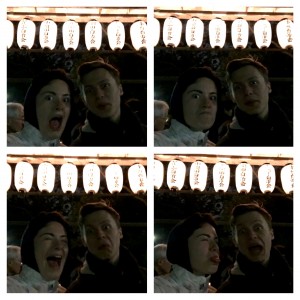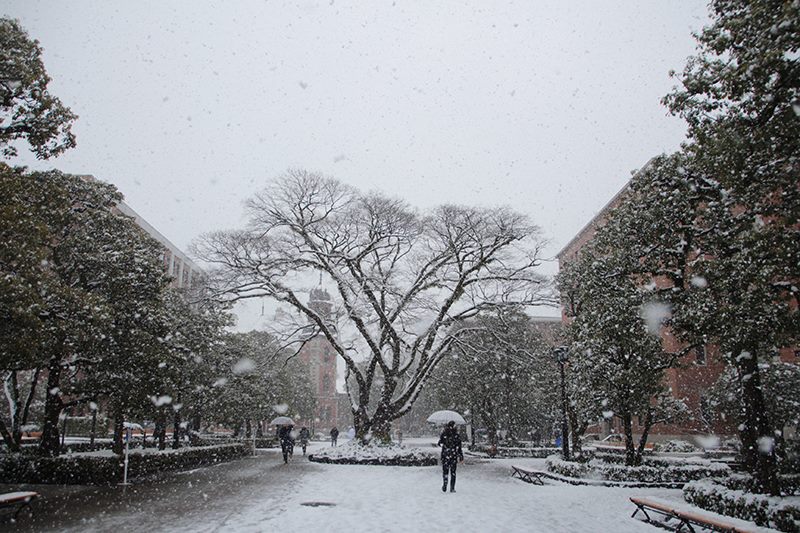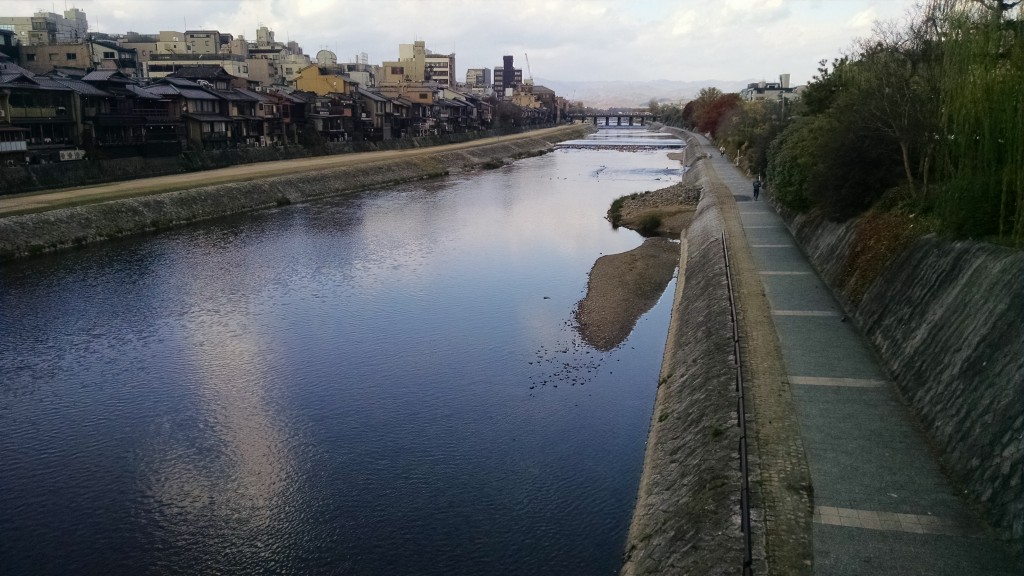Hello all,

Emma and I climbed the mountains behind Yasaka shrine and waited for the last light of 2015. It was getting a little dark and an old man who was smoking in a graveyard decided to guide us back. I decided he was a kami.
Congratulations on a new year!
I suppose some of you may be wondering why I haven’t written in a while! I can give plenty of reasons. The first is that my girlfriend is here from Whitman! My aunt who used to live in Japan has graciously allowed us to use her old house while Emma stays here with me for about a month. It’s been great to slowly become part of the neighborhood. But also time consuming. Plus, the pocket wifi router I bought to use in the house and while I’m out is iffy at best (this’ll hopefully upload eventually). But other than that, I’ve simply been too busy to post. What with Emma coming, Christmas, New Year’s, and general invitations and activities, I haven’t had much time to write. Now that the new year has come in, I at least have a bit of time to share a few memories from the past month or so. Like my first post, I think it would be fun just to share a few as they pop into my head and as I remember them: as short, meaningful blips.
My kyudo sensei told me that he usually waits till a student has practiced with him about ten times till he takes them to get a uniform and go to the dojo. For whatever reason, he decided I was ready after the fourth practice.
I showed up at his place around 3pm so that he and his best student could drive me to the shop to get equipment. Another student (who was actually quieter than I was) came with us as well. We all got in the car and drove there, with sensei in the passenger seat humming and singing along to his CD all the way. He chuckled and talked to me a lot too. He’s really slangy and hard to understand, but I also appreciate that he doesn’t hold back at all. When he talked to the other student I was glad to notice it seemed she understood him about as well as I did.
The store was small and about 45 minutes outside of the city. The walls were absolutely lined with bows and arrows and the floor space was stuffed with uniforms and gloves. I wanted to take a picture but felt a little awkward so I didn’t. They all were a bit mystified by my body proportions at first but I managed to get a uniform and a glove that fit me well by the end.
The complimented me on my Japanese (I think they were more just relieved that I spoke at all) and gave me a few free gloves and other things on the way out. The store owner’s son followed us out and made sure we backed out alright. Sensei sang on the way back as well and told me and the other student that because we have our own equipment now, he’d cut the lesson prices in half—but he said with a wink that this means we have to come more frequently now.
As part of staying in my Aunt’s old house and becoming part of the neighborhood, AKP and my host family thought it was necessary that I introduce myself to the neighbors. The old-fashioned way. I wrote out a long note in Japanese seven times to give to all the neighbors and hostmom bought hand soap (it just needs to be something small and inexpensive, she said) with me and Emma’s name on it. “That way, they’ll remember your names whenever they look at the soap.”
My Aunt’s sister (aka other aunt) came over to help meet the neighbors. I’d met her before a few weeks before, but she hadn’t met with any of the other neighbors for a long time. When we knocked on their doors to introduce them to me, they usually said two things: “It’s been so long! Why don’t you come by more often?” and “What are these? Oh wow, you really didn’t need to go to that trouble,” when they saw my soap. I’m not sure how often people do that anymore, but they all seemed surprised and amused when they saw it.
Regardless, it was a good way to introduce yourself.
I was able to go to a tea ceremony with Emma a few days after she arrived. My sensei was serving everyone tea, and most of the guests were other tea students. Some I had seen before, others I hadn’t. From what I understood, the tea gathering was first to close the year with a party, and second to break in a newly refurbished townhouse.
To put in lightly, Emma and I were in deep. Emma was actually able to come to my tea practice two days prior and meet sensei and the other students (sensei made me serve her tea), but this was the real deal. Neither Emma or I had a kimono, but we were told that a suit or a dress was fine. Others were dressed that way when we arrived.
The house was beautiful and the room for the tea gathering was huge. Probably about 25 people attended. For the first half, we sat on the ground for around two hours with a break about 30 minutes in. I was doing my best to sit properly all the way through, but my feet were completely dead for more than 2/3 of the time. I’m happy to say that as soon as I sat forward at the end on my knees to get the feeling back in my legs, it only took a few seconds to get them tingly and feely again. Just like my sensei from Whitman said, you don’t really get better, but your recovery time gets quicker.
The second half was more relaxed. Sensei was dressed in a full kimono to make everyone tea, but she and everyone else changed into dresses or suits after the official tea gathering was over. And then the real party started. The first half was more of a tea-tasting, and the second half was a wine-tasting disguised as dinner. Although its normally difficult for me to talk to older people in Japan, everyone drinks here—and that’s the chance for all kinds of social boundaries to be crossed. That was the best Japanese I’d ever spoken. Everyone was talking to me. One of the most surprising conversations I had was with a woman who came over to pour me Walla Walla, Washington wine. My sensei had brought it with him from Whitman a few days ago during a visit, but I didn’t know about that until that moment.
My tea sensei eventually came over around the end of the party to thank Emma and me for coming. Although she had been on edge during the performance and even a little shaky, she was very relaxed by the end of the night. She even shook Emma’s hand and told her to contact her anytime she was ever in Kyoto again.
Emma and I walked away in the dark to the bus stop with everyone wishing us a good night and safe travels. Friends were made.
My day was made by a simple thing a few days ago. A neighbor passed us in town on his bike and said, “Mornin’!” It felt like I was home.
I went to an outdoor market a few days ago to check out some antiques. I like looking at teabowls for fun, just because I don’t get to so often. I’m often using them instead. There’s a specific, famous type of teabowl that I keep my eye out for at these kinds of markets. It’s called raku-ware, and it’s pretty distinctive. Only the real ones have stamps on the bottom from the raku potters, though. Because of that, I often spend most of my time at markets turning over bowls to look at the bottom.
I was doing this in a booth at the market a few days ago and the vendor selling those bowls saw me. “You like raku?” “Yeah, I do.” “Hey, you should take a look at these.” He pointed out two other bowls that also ended up being raku-ware. He asked me why I knew about raku and I told him about tea ceremony. He asked what school I practiced. “Urasenke?” “No, Yabunouchi-ryu.” “Oh. Huh.” It’s not a common one, so I thought I’d explain a bit where it fit into the pantheon of tea schools. By this point his wife was also listening. “You’ve really studied this a lot, haven’t you? Hey listen, I’ll cut off the price of these if you buy two of them.” I’m sure he said that to most people, but it was also a really good deal. I decided to get them.
He was visibly surprised and made a big show of boxing them up for me. “Thanks so much. Hey, I hope to see you around here again.” Maybe I will. He seems like a good guy to know.
A few days after Christmas, I had my first practice at the kyudo dojo. I arrived early so sensei could dress me properly in my new uniform and give me a ride. He was in total sensei-mode and looked the part. I normally see him in work clothes (I think he runs a carpentry business), but he wouldn’t have been out of place at a tea ceremony or period-piece movie with the clothes he was wearing that morning.
I realized he was a big deal once we entered the dojo. All the other students and senseis gave him a proper greeting and we began. Overall, I did alright for my first time. I hit the target (once)! I sure learned a lot and I’m excited to return to the dojo. The technique is so different from western archery, but I think I’m beginning to get the hang of it.
After practice I helped sensei pack a few things into his car, and then me and two other students returned home with him, stopping at the grocery store to get a lunch of about eight onigiri. We ate them later at his house while he watched a crime-drama in his kitchen.
Emma and I returned later that evening to attend a Christmas/Holiday party put on by sensei. By the time we arrived, everyone was already drunk. At least, that’s what I thought. It was really just sensei. But he seemed drunk enough for everyone. We sat around a low table on the floor with 12 other guests and we ate out of few communal pots. He kept trying to get Emma and me to drink all his beer because no one else was for various reasons. We helped a little and ate a little, but were mostly there just to make an appearance and share Emma’s cookies. They went over very well. Especially with sensei.
The atmosphere was very different from the tea gathering earlier. This was a room full of working people who got together to eat some hot food and talk about the year. Or listen to sensei talk about obscure Japanese sayings and little-known kyudo competition rules, as it turned out most of the time. There were no suits or expensive bottles of wine and truffles. But in many ways it felt the same, too.
We ducked out after most of the cookies were eaten, but I think sensei continued on into the night much later. I hope so.
My favorite recent memory was a simple one, again. Our neighbor came over to give us a few sweets and wish us happy holidays. But on our porch in our doorway she was a little, shivering old lady. And I just had to invite her in. I asked tentatively if she had time for a bit of tea or something. To my slight surprise, she said she definitely did and came right it. I then realized that the place was a bit messy and we didn’t have much in the way of entertainment or food, but I told her to sit on the couch.
I talked with her and made her feel comfortable while Emma made her some tea. I sat across from her on the floor. We talked about the neighborhood, the house, the season… Her tea was eventually ready, and it was by coincidence her favorite kind of tea. I looked over and realized I could talk with her about my raku bowls that I had bought at the fair a few days before. We admired them together and talked about tea and antiques. Emma was making more of the cookies that she had brought to my kyudo sensei’s party and when a few were ready, she gave our neighbor some on a small plate.
By the time our neighbor had finished her tea and was ready to leave, she looked warm and happy. We shut the door while saying goodbye to her, and I realized that we had just entertained an elderly woman for about half an hour with no preparation in a house with no central heating, in Japan.
I hope more neighbors come by.
Well, that’s all for now. New Year’s parties last for four or five days in Japan, and Emma and I are going to my host family’s house for a dinner party. The feeling in Kyoto is crazy; very different. The streets are packed with people and people often will say hello to one another–“even if they don’t know each other,” as hostmom says. Emma made cookies.

Emma and I welcomed in the new year at our local shrine. We waited till midnight in a long line to ring bells and pray for good things next year. Photos by Emma.
What did you all do to welcome in the new year?
What are some of your memories? Of the past few weeks? Of the year?
Try and keep note of all the “firsts.” Who knows what this year will bring? It might be fun one day to look back and see how it all started.
Love from Japan,
Jesse





